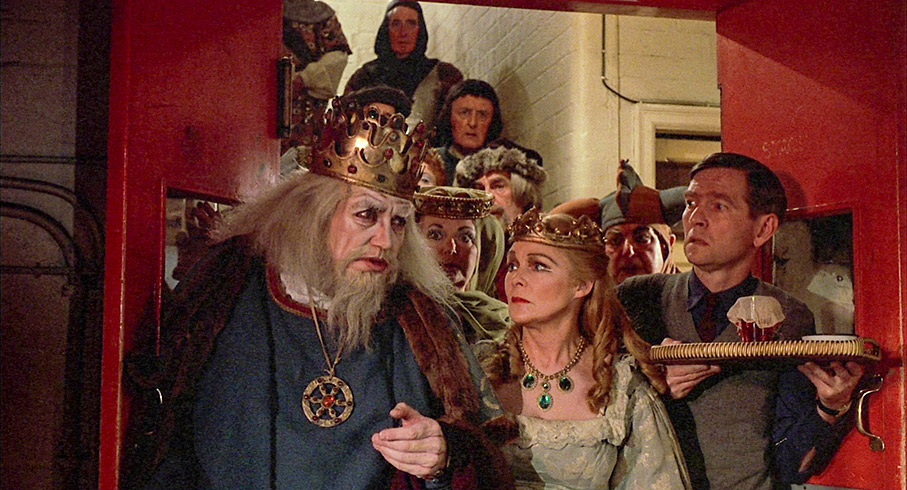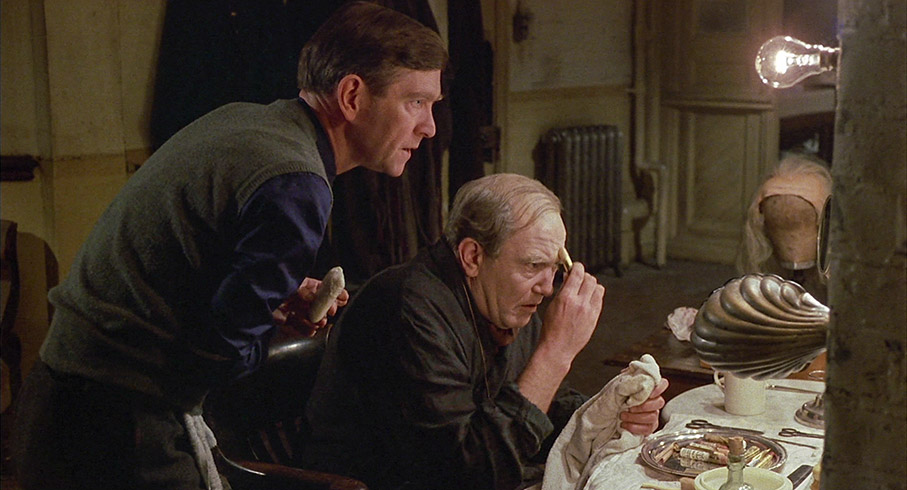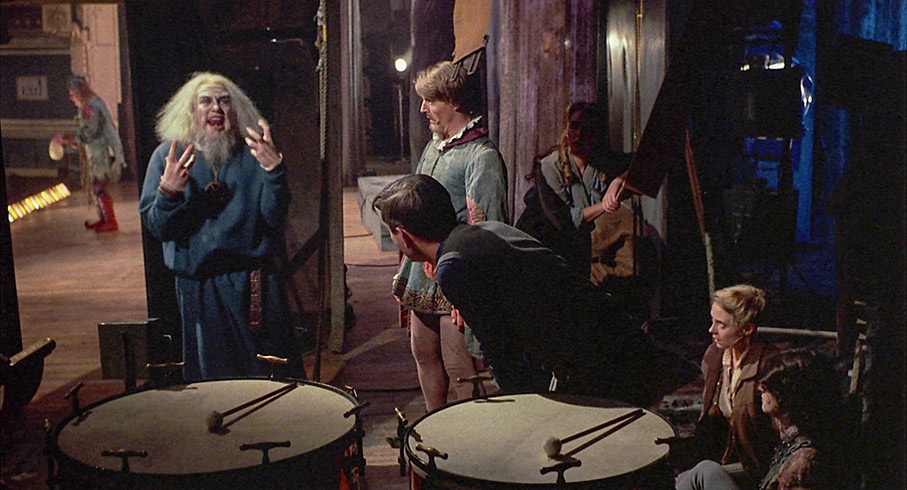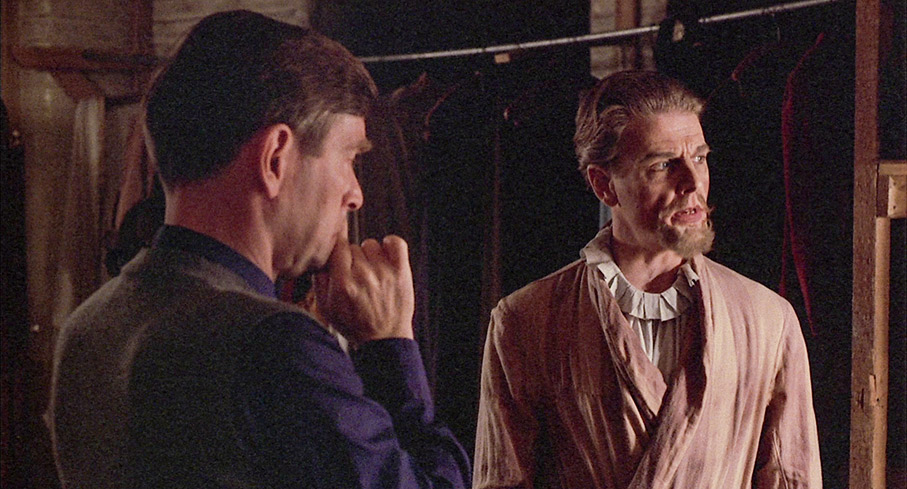| |
“I don’t think of my legacy – I think it’s a rather pompous thing to think of! All I think of is, ‘Are the plays going to live at all after my death?’ And I would be very happy if they lived. I think The Dresser will. It’s done all over the world. It’s been done in 38 languages. I saw the first performance of it in a foreign language in Paris when they did it in France and I loved it. I thought it was such a great honour to have a play done in another language.” |
| |
Playwright and screenwriter Sir Ronald Harwood, 1934-2020* |
In Britain at the height of the German bombing raids in World War II, a Shakespearean touring company, led by a brilliant but bombastic actor-manager known to all and sundry only as Sir (Albert Finney), concludes its final performance at an unspecified regional theatre before moving on to Bradford for a scheduled run of plays due to begin that very evening with King Lear. The first night is placed in jeopardy, however, when as a combination of illness, exhaustion and deteriorating mental health starts to take its toll on Sir, making him ever more reliant on his devoted dresser Norman (Tom Courtenay), who has played this role for so many years now that he is able to anticipate Sir’s every need and whim. After a very public meltdown lands the distressed and confused Sir in hospital, the company begins readying for the possibility of having to cancel that evening’s performance, and neither the actors nor no-nonsense stage manager Madge (Eileen Atkins) are encouraged when Sir discharges himself and rolls up at the theatre in a state of emotional disarray. With the house full and only a couple of hours to go until the curtain is raised, it falls to the determined and energetic Norman to pull Sir out of his confused malaise and ready himself to take the stage as Lear.
The 1998 The Dresser is in some ways a quintessential example of a film adaptation of a respected and successful stage production, which in this case was authored by Ronald Harwood, who himself worked as the personal dresser for celebrated stage actor Donald Wolfit at the Royal Shakespeare company from 1953 to 1958, an experience that he drew on heavily for his play. When it was optioned by Goldcrest for a film adaptation, a chunk of the £1.5 million budget was wisely put aside to pay Harwood to write the screenplay himself. By this point in his career, he already had experience in writing for film and television, and was thus well aware of the specific demands of both media, hence his opening up of the story to include a smattering of exterior scenes and make wider use of the Bradford theatre setting. Having said that, The Dresser is still a heavily dialogue-driven piece set primarily in one location, and if you’re going to bring a filmic edge to such a project, you need a director with real cinematic chops. Enter Peter Yates, whose 1967 British heist film Robbery landed him a gig in Hollywood directing Bullitt (1968), a crime movie classic whose central car chase sequence remains one of the most celebrated in movie history. Yates continued to make his mark with the likes of Murphy’s War (1971), For Pete’s Sake (1974) and The Deep (1977), as well as two site favourites in the shape of The Friends of Eddie Coyle (1973) and Breaking Away (1979). Before becoming a director, Yates, like Harwood, trained as an actor at the Royal Academy of Dramatic Art and had been looking for a theatre-based film project for some time, and worked closely with Harwood to bring the project to the screen. Albert Finney (another RADA graduate) was cast as Sir, and for the titular role of Norman, Yates specifically requested Tom Courtenay, who had played the role in the stage production both in the UK and on its subsequent Broadway run. Want to take a guess at which prestigious acting school he also trained?

For me, one of the key differences between live action cinema and theatrical productions revolves around their respective representations of reality. Films tend to be shot with an eye for realism, in their locations and sets, in their lighting, and, to a degree, in their performances and dialogue. In theatre, locations have to be represented or suggested by sometimes visibly artificial sets, and performances often require a degree of projection that can feel overplayed on film. The more realistic dialogue requirement of film is also not necessary in theatre, where even a humble gravedigger can deliver eloquently poetic lines without audience members exchanging confused or amused looks. Both media have their own very specific pleasures, and adapting one to the other will always have its share of challenges and potential pitfalls. Stage plays are often observed from a single viewpoint and take place in a single or small number of locations that essentially occupy the same physical space. It’s something that rarely translates well to film, where the expectation is of more locational variety and a visual language that only the framing and movement of the camera and the specific storytelling power of editing can really provide. It’s why the term “stage-bound” tends to be a critical put-down when referring to more staid film adaptations of theatrical works.
Conversely, there are films whose qualities as cinematic drama are so strong that you wouldn’t know that they were based on plays in the first place were it not spelt out in the opening titles. Sitting midway between these two extremes are the film adaptions of theatrical works where the origins are clearly visible but which stand on their own feet as works of cinema, justifying their existence beyond being functional records of great writing and performances. Think Elia Kazan’s 1951 film adaptation of Tennessee Williams’s A Streetcar Named Desire (1951), or James Foley’s film of David Mamet’s Glengarry Glen Ross (1992). Both were based on Pulitzer Prize-winning plays, the integrity of which was assured in both cases by the involvement of the original authors in the writing of the respective screenplays, with Mamet even adding a new opening scene for the film of Glengarry, one whose dialogue has become the most quoted from the film. It certainly didn’t hurt that the film version of Streetcar had three of the lead actors reprising their roles from the play’s hit Broadway run, or that they were directed by the man who had helmed that stage production. The Dresser comes with two of those advantages, being adapted for the screen by the author of the play and by having one of the lead roles played by the actor who originated it in the theatre, and who thus knew the part inside-out even before rehearsals began. That Yates, Harwood, Finney and Courtenay had all worked extensively in the theatre no doubt also contributed to the air of authenticity that they bring to the film’s portrait of wartime backstage theatrical life.
The base requirements for a solid film adaptation of a respected stage play of strong writing and performances are not only present and correct here, they are unquestionably two of the film’s principal draws. Quite aside from his success as a playwright, Ronald Harwood subsequently built a serious reputation as a top-flight screenwriter, one whose credits include the criminally underseen Operation Daybreak (Lewis Gilbert, 1975), The Pianist (Roman Polanski, 2002), and The Diving Bell and the Butterfly [Le Scaphandre et le Papillon] (Julian Schnabel, 2007). Here he draws on personal experience to craft a cleverly structured, witty and disarmingly touching portrait of two men whose working relationship is so tight that it has developed a degree of co-dependency. For all his self-importance and bombast, Sir is utterly reliant for just about everything on Norman, who has devoted so much of his life to serving the actor’s every whim that the job really has come to define him as a person. It’s got to the point where he seems to be even more of a wife to Sir than Her Ladyship (Zena Walker), the woman I was genuinely surprised to discover that Sir had actually married. I’m not in a position to say how much of Norman’s personality and behaviour is reflective of Harwood’s own, but it’s a beautifully crafted character, one whose over-energised fusspot effeminacy and nervous brandy swigs are wedded to a genuinely deep concern for the welfare of his closest and possibly only true friend.

The performances are divine, with Finney offered a rare opportunity to play to the gallery in a way that is always completely appropriate to the character and the location, a Shakespearean theatre actor whose talent and authority has enabled him to craft a larger-than-life public persona that he now inhabits as if born to it. And within this personality cocoon, Finney has to run the acting gamut, being alternately egotistical, grandiose, confused, despairing, angry, salacious, warm, panicky, exhausted, and a whole lot more, often switching between them on a dime several times in the space of a single minute. When he imposes his authority, he does so with conviction, making it oddly easy to believe his almighty bellow of “STOOOOP…THAAAAT…TRAAAAIN!!!” could genuinely bring a steam locomotive to a halt.
Brilliant though Finney unquestionably is here, he’s evenly matched and even sometimes outshone by Tom Courtenay, who inhabits the role of Norman so deftly and completely that the line between actor and character completely dissolves. It’s an extraordinary performance, bristling with the sort of nervous whirlwind energy that makes his responses to Sir’s emotional outbursts feel like spur-of-the-moment quips even as his facial expressions suggest they are well-worn lines from a mental catalogue that he regularly calls on. Courtenay also walks a fine line when it comes to Norman’s effeminacy in a way that is frequently humorous without ever slipping into mockery or caricature – I used to know someone uncannily like Norman (who was also in the arts), and every inflection and gesture here felt true to my fond memories of that that individual. It really is a joy to watch two such great actors dance with such delicious dialogue and play so effectively and believably off each other, and they’re far from alone on this score: Eileen Atkins is quietly sublime as no-nonsense stage manager Madge, who for years has ached for a romance that was sadly never to be; Zena Walker is genuinely caring and tender as Her Ladyship; Cathryn Harrison is subtly effective as an attractive young company member looking to climb the ladder by flirting with the boss; and Edward Fox is wonderfully haughty as disabled but ambitious actor and wannabe playwright Oxenby. Also making their mark in just a couple of scenes are Michael Gough as the easy-going Frank Carrington, who plans his pub visits around his stage exits, and Lockwood West as perennially nervous Geoffrey Thornton.
Although touched with melancholy from its early scenes and boasting one of the most touchingly sad final moments I can readily recall, many of The Dresser’s finest scenes are memorable for their humour. There are a handful of genuinely laugh-out-loud sequences here, none more so than the frenzy of activity that sees Norman and his colleagues furiously operating machinery to create the noise of a storm to accompany Sir’s boisterous on-stage performance. This builds to such a manic pitch that even the previously aloof Oxenby is sucked into the tornado of activity, and boasts glorious payoff in the shape of Sir’s reaction, which I have no intention of spoiling for newcomers. And if you’re new to the quaint superstitions of the theatrical world, you’ll doubtless be left scratching your head at the comically peculiar ritual that Norman forces Sir to go through after he mentions what actors with whom I have been friends would always insist on calling “the Scottish play”.

The Dresser is a wonderful example of how a stage play can be successfully adapted for film without distilling the essence of the theatrical experience. Great writing, superb performances, a lovely feel for the period, and smart, unobtrusive direction and intelligent blocking of actors from Yates make this an absolute winner on all fronts. And yet, for all Finney’s undeniable excellence here, I can’t help feeling for actor Freddie Jones, who played the role on stage for its UK run, but lost out when the production moved to Broadway, apparently due to union rules (I don’t know the specifics), only to also not be offered the role in this film adaptation. I never saw the stage original, but theatre critic Michael Coveney later said of Jones, "No subsequent performance in The Dresser – not Albert Finney in the 1983 film, nor Anthony Hopkins on television in 2015, nor Ken Stott in the West End in 2016 – matched the rumbling thunder of Jones."** What I wouldn’t give to have seen that.
Presented in the film’s original aspect ratio of 1.85:1, the transfer on Indicator’s Blu-ray was sourced from an HD master supplied by Sony, and I know no more details about it than that. A degree of restoration has clearly taken place, as there are next to no visible dust spots or other signs of wear, and the image sits solidly within the frame throughout. The contrast is very nicely graded, keeping intentionally dark areas pitch black but capturing plenty of detail in less aggressive shadows, important for a film that takes place largely in the theatre, where bright lighting is confined almost exclusively to the stage. The film’s warm colour palette, which subtly suggests the period without going all sepia on us, is also pleasingly reproduced here, and a fine film grain is visible. Nice.
The film’s original stereo soundtrack is here reproduced in Linear PCM 2.0, which presents the all-important dialogue with pleasing clarity and no background hiss, with only the loudest, treble-leaning sounds (escaping steam when the train at York station is halted on Sir’s command) coming close to being just a tad shrill. There is, however, little in the way of clear frontal separation, and for the most part it plays as dual mono track, which for this film works perfectly well.
Optional English subtitles for the hearing impaired are included.
Tom Courtenay: Hitting it Off (7:32)
A new interview with actor Tom Courtenay, who recalls first reading and being bowled over by Ronald Harwood’s play, the delays in getting it into production, being cast by Peter Yates in his first film in over a decade, his working relationship with Albert Finney, and their resulting friendship.

Cathrine Harrison: A Good Adventure (3:44)
A new interview with actress Cathryn Harrison, who recalls Ronald Harwood being very involved in the production, and how scary Tom Courtenay was as Norman when he confronts her after her encounter with Sir. She confirms that the production was a lot of fun to work on, and tellingly says of one of her fellow actors, “Edward Fox was in it being very Edward Fox, he was sort playing himself, but magnified.”
Behind the Curtain (13:57)
In another newly shot piece, some of the technicians who worked on The Dresser look back at its making. Camera operator Dewi Humphreys describes Peters Yates as a consummate example of what a director should be, and has a couple of interesting stories about the execution of potentially complicated camera moves, while director of photography Kelvin Pike remembers delighting the production design team when he decided that the sets should have visible ceilings (studio sets often do not in order to make them easier to light). Property buyer Jill Quertier talks about the process of researching and getting approval for the many period props, property master John Chisholm recalls everyone applauding at the end of Tom Courtney’s climactic speech, and dubbing mixer John Hayward describes how he added echo to Albert Finney’s station bellow, only to then admit he dislikes playing such games with natural sound. “But because Peter wanted it, Peter got it,” he pragmatically notes.
Theatrical Trailer (2:40)
A decently assembled, 4:3-framed collection of clips from the film that do at least give a flavour of its content and tone, though they’re set to the sort of generic and inappropriate music that you tend to find today on copyright-free sites when looking for a background tune for your YouTube video.

Booklet
In the absence of a commentary track, the lead essay in this 32-page booklet by film critic and independent researcher Thirza Wakefield will do very nicely. She provides some welcome and detailed background on the historical situation in which The Dresser is set and the decline of the actor-manager role in theatre, as well as delivering a compelling and thoughtful analysis of the film. Next up is a series of extracts from interviews from the early 1980s with director Peter Yates, writer Ronald Harwood, and actors Albert Finney and Tom Courtney about The Dresser, which usefully builds on and adds to the information provided by Wakefield in her piece. This is followed by extracts from a range of largely contemporary reviews, which are positive in tone and include an interesting allegorical reading from screenwriter and critic John Brown. Full credits for the film are included, and the booklet is well illustrated.
Coming back to The Dresser after a break of several years, I was really impressed not just by how well it stands up but how utterly engrossed in it I once again became. I first saw it on its initial cinema release and distinctly remember the positive reaction of the audience and the widespread laughter at the film’s comic moments, as well as the attentive silence during the moving final scene. It remains a small-scale triumph of filmed theatre, one whose writing, direction and performances are all excellent, and its presentation on Indicator’s Blu-ray is once again top-notch. A warmly recommended disc, both for those who know the film and those you have yet to experience its pleasures.
** https://www.theguardian.com/film/2019/jul/10/freddie-jones-obituary
|